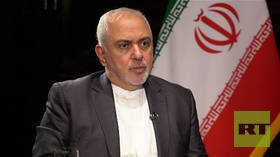Russia favored for half-trillion dollar Iranian oil project
With most US and European oil majors side-lined, the huge South Pars Oil Layer project will most likely go to a Russian or Chinese partner.
Last week’s announcement from the director of integrated planning at the National Iranian Oil Company (NIOC) Karim Zobeidi that the South Pars Oil Layer (SPOL) project will be assigned to Iranian companies is just part of a holding position allowing for some development of the field whilst Iran can negotiate a deal with an international oil company (IOC) partner.
Also on rt.com Iran will give Europe two months to save nuclear deal - Rouhani“Right now we have reached a point where either the US will be persuaded to come back to the negotiating table to discuss re-engaging with the JCPOA [Joint Comprehensive Plan of Action] or it will be sidelined in this and Russia and China, and to a lesser extent Europe, will just go about their business with Iran regardless,” a senior oil and gas industry source who works closely with Iran’s Petroleum Ministry told OilPrice.com last week.
Up until the moment the US decided to withdraw from the JCPOA last year and then to re-impose sanctions, Iran had a number of potential IOCs vying to sign the Integrated Petroleum Contract (IPC) for the SPOL development. This was unsurprising for three reasons. The first is that the SPOL is conservatively estimated to hold around seven billion barrels of oil, albeit located around 100 kilometers (62 miles) from the Iranian coast, in the northeastern extension of Qatar’s Al-Shaheen field in the Persian Gulf. Given that the site is located at around 67 meters (220 feet) water depth, the lifting costs (excluding capital expenditure) will be higher than the usual $2-3 per barrel range in Iran – the lowest in the world, along with Iraq, and Saudi Arabia.
The second reason is that some work has already been done on the site by Iranian companies, including the Petroiran Development Company (PEDCO), including drilling a number of oil producing wells, completing topside operations, and the development of the reservoir’s static and dynamic models. As of now, the SPOL is already producing an average of 25,000 bpd, up from the initial 5,000 bpd begun in March 2017, but the plan by the end of Phase 3 is for it to produce at least 150,000 bpd. Phase 2 production will be around 55,000-60,000 bpd and will involve the deployment of another 47 or so further rigs and some work over wells.
From Iran’s perspective, optimizing oil flows through the involvement of a well-equipped and well-functioning IOC is a key to optimizing the production structure of its oil industry as a whole.
“Onshore, around 6-8% of fields are experiencing loss of output that can only be restored with EOR [Enhanced Oil Recovery] techniques, whilst offshore the figure is between 12-15%, we think,” Richard Mallinson, senior cross-energy analyst for global energy consultancy, Energy Aspects, in London, told OilPrice.com.
Aside from the prospects based on the flows already established, the third reason why involvement in the SPOL project was, and remains, an attractive proposition for IOCs is that it puts them on the short list – currently a very shortlist due to US sanctions – for further development opportunities to monetize Iran’s massive, and still relatively under-developed oil and gas sector.
“The NIOC has hinted that for IOCs that become involved with the [South Pars] Oil Layer, preferential consideration will be given to become involved in the Chesmeh Khosh, Sohrab, Jofeyr and Darkhovein fields, plus some of the even bugger fields in the West Karoun region,” the Iran source told OilPrice.com.
Previously, the principal IOCs with interests in the SPOL was Denmark’s Maersk Group and French oil super major Total. Ironically, given the subsequent turn of events regarding Iran’s supergiant non-associated South Pars gas field, many in the oil industry believed that one of the reasons for Total’s $7.45 billion (€6.4 billion) purchase of Danish A.P. Moller-Maersk’s oil and gas unit was to boost the French company’s chances of being allowed to run the flagship Phase 11 of the South Pars field via being allowed first to develop the SPOL.
Also on rt.com Iran says France offered $15bn oil pre-purchases credit lineAccording to the Iran source, Maersk was just days away from being awarded the SPOL contract – alongside Royal Dutch Shell - before Iran’s NIOC heard that Total was going to buy the Norwegian firm, so held off awarding the contract.
“At that point, when Iran was the hottest ticket in town, before Total was awarded the South Pars Phase 11 contract, the understanding between it and the Petroleum Ministry was that the French would also sign up for the South Pars Oil Layer and also to develop the huge South Azadegan oil field in West Karoun,” said the Iran source.
“But the conclusion reached was that these two latter projects would have to be delayed as otherwise Iran’s hardliners, mainly senior figures for the IRGC [Islamic Revolutionary Guard Corps] at the time – who were saying that Iran was selling out to the West – would cause considerable trouble for [Iran’s President, Hassan] Rouhani,” he added.
As it stands, with the range of US sanctions still in place, the chances of a Western IOC coming back to the SPOL is near to zero. Whether or not recent events – including apparent overtures from various US figures about “talks with Iran” or indeed European efforts to get the US back to the negotiating table (seen in Iran’s unexpected appearance at the recent G7 summit at the invitation of France) come to anything remains to be seen. As highlighted exclusively in OilPrice.com, though, Russia remains more than happy to step into the power vacuum created, as is one of its core foreign policy strategies.
This article was originally published on Oilprice.com














